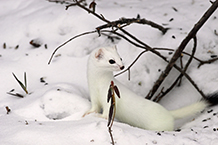
Written by Kennedy Zittel, Land Management Intern
As the other interns and I walked along Cattail Trail enjoying the sunny winter day, Jenna stopped along the boardwalk and pointed out that the cattails were moving! To our surprise, we saw a weasel! Perfectly blending into the snow besides the little black-tipped tail, this small creature was dragging a large bird across the ice right next to the boardwalk that we stood on. Given how well this animal blended into the snow, it was no wonder how the bird that it caught didn’t see it in time. When we got back to the nature center we began to research to try and figure out what type of weasel it was that we saw.
The three main types of weasels within North America are long-tailed weasels (Mustela frenata), short-tailed weasel (Mustela erminea), and the least weasel (Mustela nivalis). These three weasels vary in size with the long-tailed weasel being the largest, then the short-tailed weasel, and the least weasel is the smallest. Long-tailed weasels are around 13-18 inches long with a 4-6 inch black-tipped tail. Short-tailed weasels are around 12 inches long with a 2-4 inch black-tipped tail. Least weasels are only about 6 inches long with a short tail that lacks a black-tip. The least weasel is also the smallest carnivore (of the order Carnivora) in the world!
After we learned more about the sizing and coloration of the three weasels, we decided that we saw a short-tailed weasel, also known as an ermine. This was based on how it had a black-tipped tail (ruling out the least weasel) and how it had a tail length and body size that was more comparable to the short-tailed weasel.
Weasels (mammals of the genus Mustela) include least weasels, short-tailed weasels, long-tailed weasels, polecats, stoats, mink, and ferrets. The family that weasels belong to, Mustelidae, includes badgers, wolverines, and otters too. Weasels are small predators that have long slender bodies with relatively short legs. The slenderness of their bodies enables them to follow prey into small burrows. Mice and voles make up a majority of the weasels diet (around 60-80%). Weasels will also eat frogs, birds, and rats. Within the warmer months, all three weasels have dark brown fur with a creamy white colored stomach. During the colder months all three weasels fur may turn white to help them better camouflage with the snow. Weasels are also crepuscular, meaning that they are active at twilight (dawn and dusk) which explains why we saw one early in the morning.
Cattail trail has brought us so many different wildlife sightings, regardless of the time of year. We have seen muskrats coasting through the marsh, mink scampering along the boardwalk, bald eagles soaring in the sky above, a weasel sliding across the ice, and so much more. The sighting of the weasel was a good reminder to us all that when you go out into nature, just take your time and really look around you so that you see all of the wonderful things that surround you. If Jenna wouldn’t have stopped on the boardwalk to gaze out at the marsh none of us would have seen the tiny predator dragging his meal across the ice. Seeing such a tiny creature with such a large meal slipping across the ice brought us all great joy, and it will be a story that we all tell for a long time.
photo- short-tailed weasel from Wisconsin DNR
